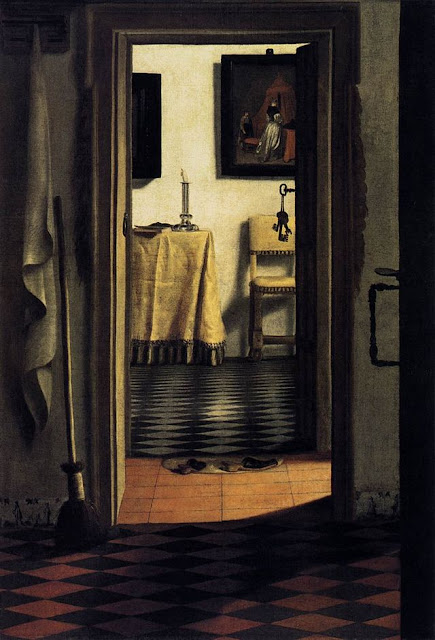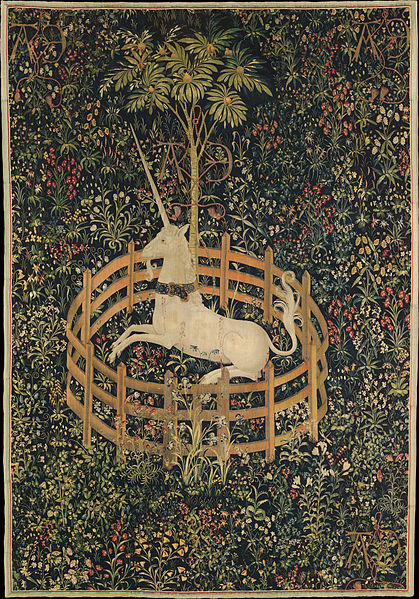However there is more than meets the eye in most Dutch genre paintings. Often rather than portraying common activities, genre paintings contained moralizing messages or were allegories of virtue or vice.
Contemporary 17th century viewers would have recognized many levels of symbolism, including the meaning in the painting within a painting. Let's look at some examples of Dutch genre paintings that have small works of art in the background to better understand their variety of meanings.
 | |||
| The Love Letter, Vermeer, 1669, Rijksmuseum |
A ship at sea was a common metaphor for love and that is the subject in the botttom painting. What is going on with the ship gives the viewer a clue as to what is in the letter. Is the ship on a calm sea? Then all is well and the reader will be getting good news. Is the ship on a stormy sea? This may mean the reader is receiving some troubling information. In the Vermeer the ship is on a calm sea, but clouds are rolling in.
Man Writing a Letter/Women Reading a Letter, Gabriel Metsu, 1664-66, National Gallery of Ireland
Gabriel Metsu created these two works to hang together as companion pieces. In the first a young man is writing a letter and in the second a young woman is reading a letter. The viewer is meant to understand he is writing a love letter to her, though their exact relationship to one another isn't known.
We can understand by his surroundings that he is traveling, there is a large globe that sits in the corner of the room behind the open window and an oriental carpet is being used as a tablecloth. The painting on his wall is a pastoral landscape.
In the other painting we understand with the inclusion of the little dog that the woman is being faithful, in the foreground there is a tiny thimble which lets the viewer know that she was so excited to get her letter she jumped up in the middle of her needlework.
As the woman reads her letter, her maid pulls back a curtain over a framed painting to reveal two ships on stormy seas. Due to the fact that Metsu shows us that the man is fine and that he created these two works to be hung together, the rough seas would likely be a symbol for the turbulent nature of love, especially when spent apart from a loved one, rather than a symbol of bad news.
 |
| The Slippers, Samuel van Hoogstraten, 1654-62, (Louvre) Another type of genre painting which commonly used a painting within a painting were those with a moralizing message. We can see an example of this in the van Hoogstraten work known as The Slippers. At first glance the viewer sees a quiet interior setting with two slippers in the foreground. On closer examination the work is an allegory of lust and temptation. The slippers are not a set, there is one man’s and one woman’s. A broom in the foreground has been left to the side as if to suggest that the woman who was cleaning and a man are in the bedroom together. The painting within the painting here, the Father Admonishing his Daughter by Netscher (a variation on a well known work by ter Borch) was actually a painting that takes place in a brothel. The contemporary viewer would have taken note of this and immediately understood the allegorical message. The Doctor's Visit, Jan Steen, 1665 Museum Boijmans Van Beuningen (Rotterdam) In the same vein of allegories of lust are the many versions of The Doctor's Visit, painter Jan Steen in particular created a number of these. A doctor's visit genre painting typically shows a young woman being visited by the doctor (often shown as a quack) and contains clues that she isn't sick, but rather is pregnant. In this particular painting everyone but the young woman seems to know this and to be laughing about it. To give an added clue here the painting above contains two embracing lovers. The paper on the floor states, "No medicine is of use, for it is lovesickness." Other versions of messages within paintings contained religious themes. During this time the Netherlands was strongly Protestant and religious works were no longer being painted or hanging in churches. However religious imagery can be found in many of the paintings within a painting, which is interesting in genre scenes as it would be very uncommon to find these within the average home. In Vermeer's well known work Woman Holding a Balance, the woman in the painting is dressed in the finest clothing and is surrounded by a variety of expensive jewelry and pearls. She holds up a small empty balance scale, perhaps to weigh some of her jewelry. This genre scene takes on an entirely new meaning when the painting in the background is taken into consideration. Here we see the Last Judgment and the analogy can be made that Christ will be holding the ultimate balance, weighing the souls of the saved and the damned. It is perhaps a reminder to the viewer that regardless of the riches you accumulate in life, it is important to take care to live a life of virtue and realize your immortal soul will ultimately have more weight than your possessions. The Sick Child, Gabriel Metsu, 1663, Rijksmuseum In our final example we turn again to a Christian religious painting on the wall, this time it is a Crucifixion. In Metsu's The Sick Child, a young mother holds her little child in her lap. The child looks pale and unwell and slumps across the mother's legs, much like a modern version of the Pieta found in Italian Renaissance art. Interesting to note too is the fact that the mother is dressed in a gray shirt, which would have been common, but has a blue skirt with a red undertunic. At this time women would dress in simple colors in day to day activities, but the Virgin Mary is nearly always shown wearing a dress of royal blue (the color associated with her) with a red undertunic (red symbolizing the blood and Passion of Christ). The fact that the mother is wearing these colors and that on the wall we have a picture of the Crucifixion of Christ lets the viewer know that Metsu is drawing a comparison between this mother and sick child and the Madonna and Christ. But what message exactly is he sending the viewer? He may be likening the sacrifices all mothers make to those of the Virgin Mary, or reassuring parents that she would know how it felt to be worried about your child. Perhaps Metsu wants to remind viewers not to worry about things such as sick children since Christ has died to bring salvation to everyone. The exact interpretation would likely have been more apparent to the contemporary viewer. While the meanings of a painting within a painting vary, always make sure to take note of what the artist has chosen to embed in their paintings. The subjects within these frames within frames always enhance the viewers understanding of a painting. |












 A
A

